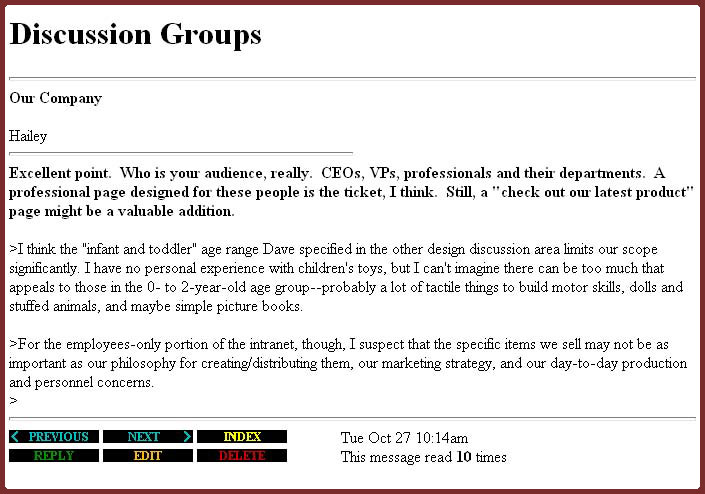For nearly 44 years, IMRL has researched and solved problems in interactive media and digital publishing and has made those solutions available to educators and professionals in the industry.
The Research of IMRL's PI, Dr. David Hailey.
IMRL was not officially a lab until 1995. But was nonetheless active well before that . . .
Although, Interactive Media Research Laboratory was not officially an entity until the mid-90s, Dr. Hailey was researching the new phenomenon called "desktop publishing" and something, even newer, called "hypertext" as early as 1985. At that time, and until the late 80s and early 90s, the Internet was still split into a variety of ...nets (e.g., bitnet, Southnet, telnet). So Dr. Hailey's early work was with early versions of PageMaker and Major Bulletin Board Systems (Major BBS) software. Using such a bulletin board system, one person could use a modem to contact a remote computer to download or post content. Although the system was extremely cumbersome and slow, it did permit a kind of hypertext publishing. Using Major BBS, Hailey was able to create something resembling a hypertext journal for the University of New Mexico's English department (ej, the Electronic Journal of the English Language, Literature, and Pedagogy).

ej: the Electronic Journal of the English Language, Literature, and Pedagogy -- an early hypertext journal
At that time there were several primitive applications available for creating a primative server. One computer would call another computer by dedicated land line. Modems, at that time, operated at 300 bauds per second, so everything was slow and cumbersome. Still, it did permit something resembling hypertext.Major Board System was one of those applications.
The interface and content was produced using ASCII characters. Ultimately, the process was too slow and cumbersome for effective use as anything resembling mass media. It was a good study, however, and the results were presented in 1992 at the RMMLA conference at the University of Denver.
Hypertext parachute design guide done with ToolBook software.
In 1990, Asymetrix software released a hypertext authoring software called "ToolBook." The Department of Energy at Sandia National labs provided Hailey with a copy, and he began building hypertext documents that could be viewed on dedicated computers (kiosks). One of his early projects was a parachute design guide based on a hard-copy version published by the American Institute for Aeronautics and Astronautics.
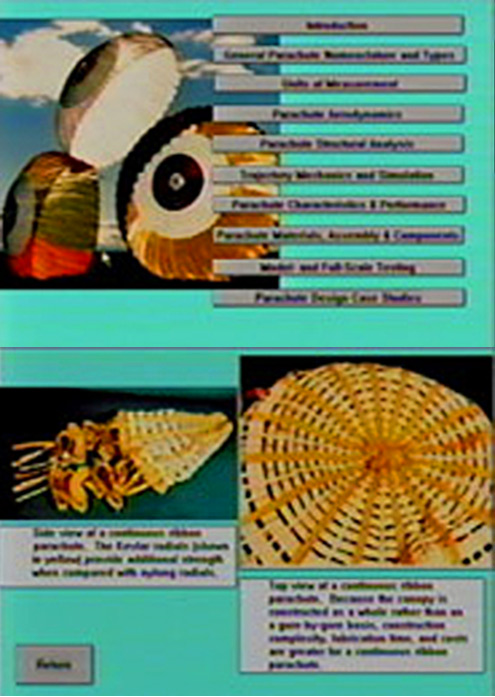
Pages from a hypertext parachute design guide.
The project was never published , but it provided interesting insights that would be important a few years later when IMRL would produce hypermedia, parachute related, training for Sandia National Labs.

Native American comparative literature textbook
This was a part of a larger effort involving an anthropologist doing a hypertext game and Dr. Hailey doing a literature textbook that demonstrated how native American mythologies are fundamentally different from European myths, and so their literature is different in fundamental ways from contemporary American literature. U.S. West provided a $294K grant. Because the Internet was still primitive, there was the possibility that U.S. West could become an instructional provider.
Hypertext manufacturing engineering safety instruction module -- 1 of 13 similar projects.
This project, developed in ToolBook, was done in cooperation with the College of Engineering at Utah State University. The product was a hypertext, machine shop safety manual.
At this point in the history, it was impossible to use good video. Mp1 was available, but to play a video required an MPEG video card on the kiosk computer. This series of modules used pop-up slides with accompanying sound bites presented in a linear progression. We were, however, able to do some excellent research on digital teaching and learning.
IMRL becomes a lab and takes on larger projects
In 1995 IMRL became lab. Shortly thereafter, Dr. Hailey was awarded a $300k grant to help build an online English composition program. Because he was already working on the above U.S. West project, he passed the Principal Investigator role for the project to Professor Christine Hult. She pushed the project to completion. Dr. Hailey, in the mean time, taught in the program in an effort to identify successful and unsuccessful models.
The program was taught as an assymmetric, online seminar. Because everybody wrote everything, while nobody said anything, the program was a major success.
Online English composition program
This is (to the best of our knowledge) the first program of its kind. At the time, there were no apps capable of delivering such a class, and we had to develop our own -- Syllabase (awarded Best Instructional software by the Association fo Teachers of Technical Writing). This is a small sample of a discussion from an early class.
This research was published as “Online Education Horror Stories Worthy of Halloween.” in special issue of Computers and Composition, Winter 2001.
“and Virtual English at USU: a Five Year Journey.” in Computers and Composition Online, spring 2000. and in more than a dozen conference presentations.
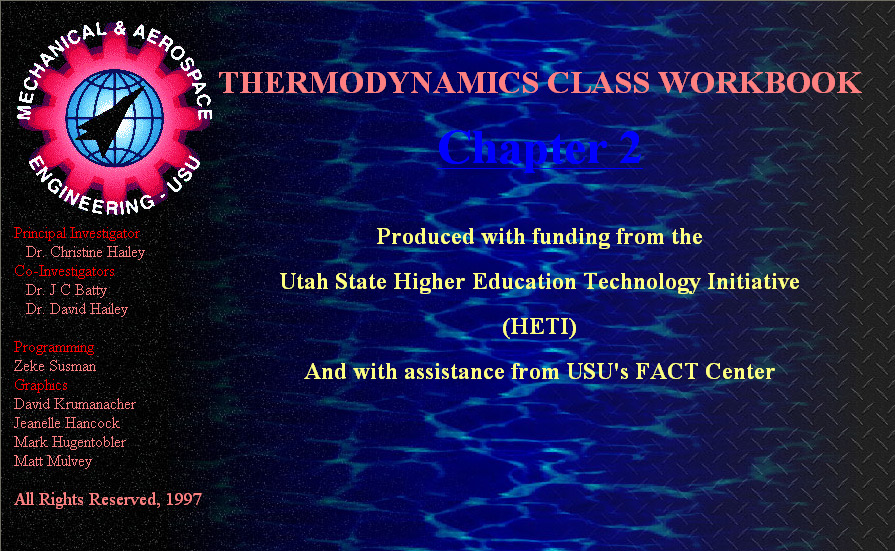
Hypertext workbook for Engineering Thermodynamics for Instructional Technology, Utah State University, and the State of Utah.
In 1996, we received a $25,000 grant to develop a hypertext workbook for the Mechanical Engineering department at Utah State University. The Workbook was broken into segments that first instructed, then tested student learning. The workbook was approximately 80 hyperlinked pages done in Perl and HTML.
Results from this study were published in “Evaluation of Instructional Design of Computer-Based Teaching Modules for a Manufacturing Processes Laboratory.” in Journal of Engineering Education, June 2000 and a number of conference presentations.

Two kiosk-based instructional modules produced for The Department Of Energy at Sandia National Labs -- $78K each.
These were two more than 300 “page,” step-by-step instruction sets produced in 1997-98 for Sandia National Laboratories.
The only man in the U.S (currently working) who knew how to rig a nuclear weapons parachute was retiring and was not going to be replaced. SNL wanted to archive the process in case they needed it done in the future. For one of the chutes, the rigging process takes 40 hours. For the other, the process takes twice as long. The processes involved thousands of steps. Results from the research were published in Proceedings of 2001 Annual Conference of the American Institute of Aeronautics and Astronautics, May 2001.
Results from this project were published Proceedings from the Annual IEEE/SIG-DOC Conference, Autumn 2000 and
“Preserving Important Processes Before They Are Lost.” in Proceedings of 2001 Annual Conference of the American Institute of Aeronautics and Astronautics, May 2001.

The engine in the above example is animated with ActionScrip, demonstrating the four cycles typle of a 4-stroke engine.

Complete thermodynamics class underwritten by Iomega Corp.
This class included all 48 hours of the classes required of this course.
This is a video of the teacher of record explaining how to identify, mathematically, the point where water becomes vapor. The 48 video project includes an entire Thermodynamics class at Utah State University. Because the Internet, at the time, was too slow to carry high quality video, the lectures were designed to be stored on Iomega portable drives in the school library, where students would check (was used 2002 at the University of Texas to allow students who had previously failed the course to take it again independently). Actually, the classes could be stored on any external (or internal) hard drive. The courses were also used at Utah State University to permit students re-examine specific lectures or to examine lectures they may have missed.
Moving to the Internte
Eventually, the Internet became fast enough for high-speed, high-quality video. In about 2004, IMRL switched to producing Engineering instruction over the Internet. The list of courses built includes the following:
- manufacturing engineering
- heat transfer
- electrical engineering for non-majors
- intro to electrical engineering
- statics and dynamics
- graduate level orbital mechanics
- Technology and the writer.

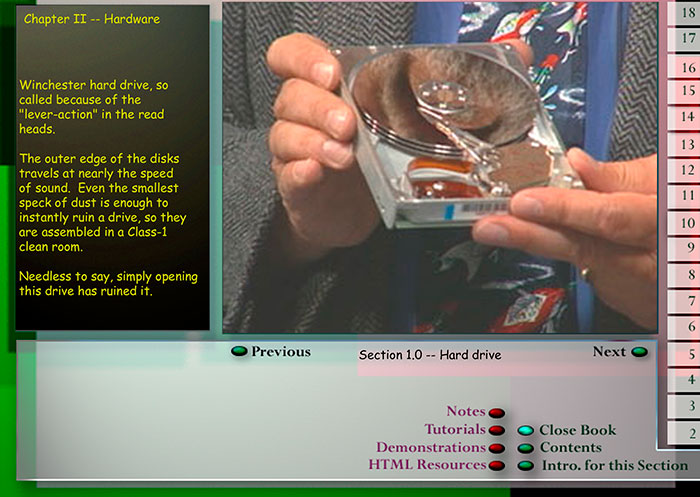
Internet-based Technology and the Writer course
Results from these projects have been published in more than a dozen different chapters, articles, and conference presentations.
These classes were also used at UT Tyler.
Discussions of this project were published as “How Genre Choices Effect Learning in a Digital Environment.”in Journal of Engineering Education, October 2003 and
"Thermodynamic Cycles: A Multimedia, Independent Study Course." in Computers in Education Journal, November 2002 and
"Genre Theory, Engineering Education, and Circumventing Internet Bandwidth Problems." Proceedings from the 2002 IEEE/ASEE Conference, Boston, November 2002 and
"Genre Theory, Technology, and Knowledge Distribution." in Proceedings of the 2002 IPCC Conference, Portland, September 2002 and
"Overview of a Distributed-Hard-Drive-Based Educational Plan." in Proceedings of the 2002 ASEE Gulf-Southwest Annual Conference, The University of Louisiana at Lafayette, March 2002
Asynchronous, online education
In 1995, IMRL was principal investigator (PI) in developing the first Internet-based English composition program. Spinning out of that, in 1996 it was PI for the development for the first online Master’s in Technical Communication. For years, this master’s was recognized as one of the 4 best in the country.


Page from an early online master's course in Technical Communication.
While Syllibase, the software developed to host these classes, was adequate for our purposes, it became vulnerable to hackers, so we ultimately abandoned it and adapted to BlackBoard. We ultimately established that, in many respects, this method of producing a graduate seminar was preferable to face-to-face for graduate tech comm. courses. It allowed us to teach students as far away as Uzbekistan, Israel, Thailand, and Japan.
Results from this research have been published as "20 Years of Teaching Online: What Worked for Us" Amityville. Rocky Mountain Modern Language Association Conference, Santa Fe, NM, Oct 2015 See paper.
Virtual Reality as a creative writing autobiography. Produced as an art project and shown in a conceptual invitational show in the art museum in San Diego, Ca.
Hypermedia has amazing potential for creative writers. They open the idea of book to possibilities we have only begun to recognize.
Anybody who knows anything about literature knows that you cannot trust the narrator in an autobiography or Memoir. So why not do an autobiography presented as a retrospective art show. The author in this case gives up all control of the reader, who examines the material and forms his or her own opinion.
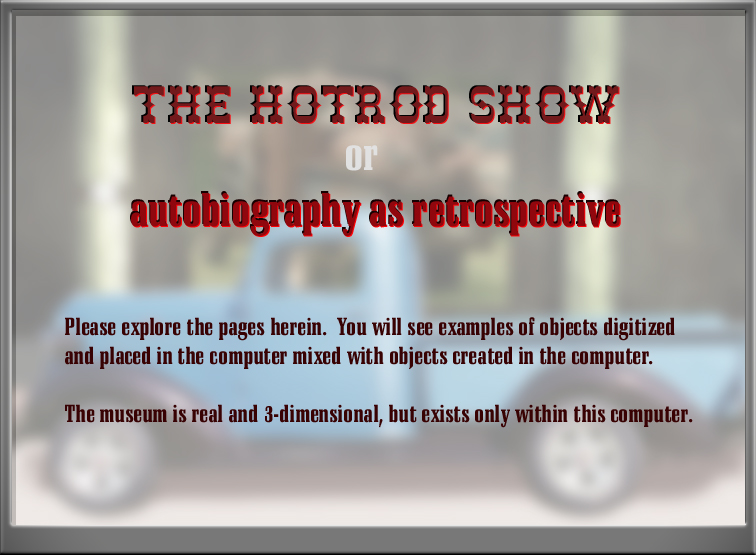

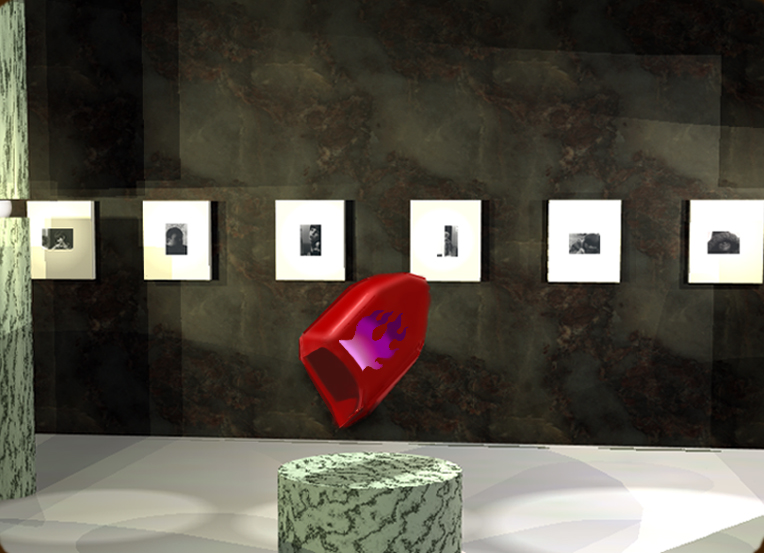
 .
.
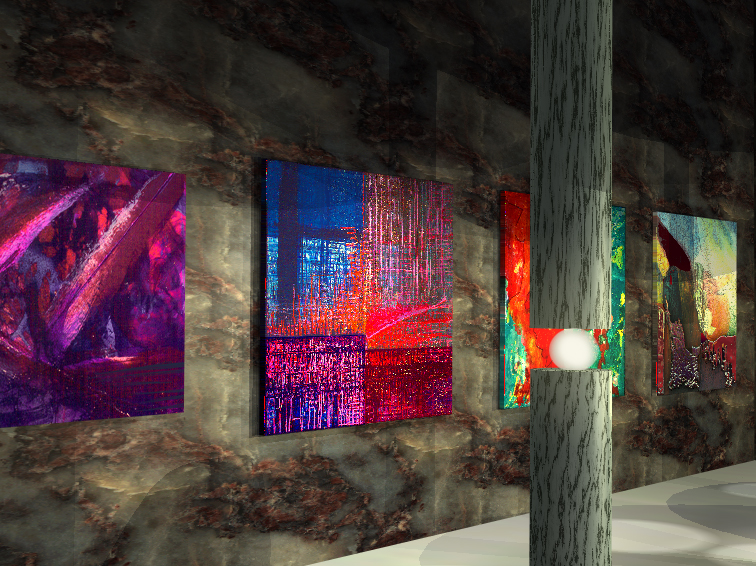
This was the first of a variety of studies into 3-D modelling to create a virtual reality experience.
Water Studies
During the first years of the 21st Century, we examined how water behaved in animation and virtual reality.
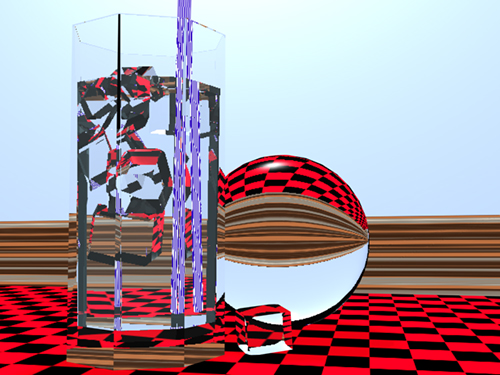
Produced in 3d as an examination of refracted light in a ray tracing environment.
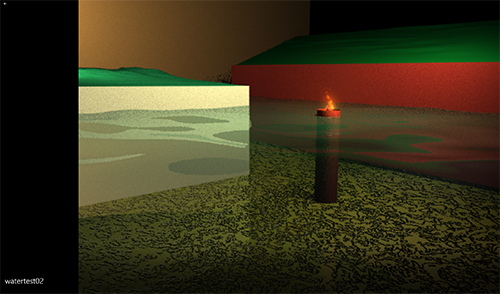
Produced using Maya software to simulate moving waves.
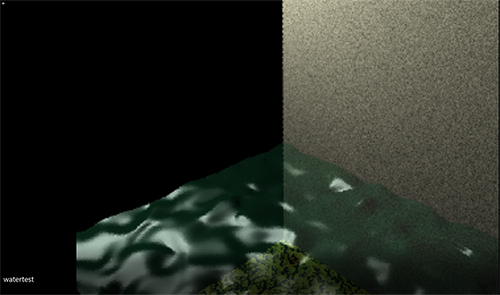
Produced in Maya software to simulate turbulance.
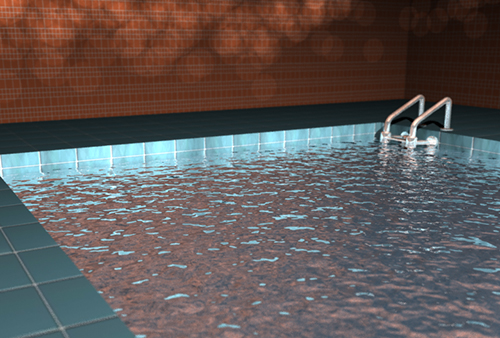
Produced in 3ds Max to examine reflected caustics.
Students were able to study 3d animation in independent study classes.
Discussion of these studies appeared as “A Next Generation of Digital Genres: Expanding Documentation into Animation and Virtual Reality.” in Proceedings of the 22nd Annual International Conference on Design of Communication, Memphis, October 2004.
Complex and complicated information systems (CCISs)
In 1997, usability studies were becoming all the rage. Our university set up its own usability lab, and developed a course in usability studies. At the same time, associates in IMRL noticed that while usability studies were excellent tools for evaluating navigation in a website, they represented only one source of information. They say nothing about quality of any text or about quality of metadata or code or design.
IMRL began investigating this problem, and immediately discovered that it was far worse than expectations. In one study of more than 100 professional writers, not one was able to identify and explain any of the glaring errors in the texts of a simple website.
Ultimately, we identified the problem. The writers were evaluating texts without knowing what their genres were. Without knowing the genre, you cannot know what the text is supposed to do, and without knowing that, it is impossible to say whether the text is doing its job. For example, if you examine product descriptions on Amazon.com, you will notice that most people describe the product. Actually, “Product Description,” should be called “Marketing Description” or “Sales Description” because that is the only place on the page where the vendors can actually sell their product.
The larger companies usually get it right, but the smaller ones always get it wrong.
The problem is this: in traditional media, a document is usually made up of a single genre supported by sub-genres. A proposal will contain an introduction, biographies, CVs, work plan, schedule, budget, and more. They will all be in the same voice, have the same audience, and have the same purpose of supporting the larger goal of the proposal. This is not the case with webpages. An Amazon page will have a spec sheet, a variety of menus, product description, and reviews. These are all decidedly different genres serving different purposes. Almost every complicated page on the Internet is like that. While a novel might be compared to a bone-in ribeye, the webpage would best be compared to a Cobb salad. Having identified the problem, IMRL is now working out solutions and making them available to the profession. That is the purpose of this site . . . demonstrate the problems and the solutions to those problems.
We have been studying this problem for 20 years, and are developing solutions.
Problems and solutions have been published as ReaderCentric Writing for Digital Media: Theory and Practice. Amityville , New York: Baywood Press, 2014. and
“Reader-Centric Writing for a Prosumer Market: Effectively Using Professional Writers to Create and Maintain Content and Metadata in digital media.” Chapter 19 in Frameworks of IT Prosumption for Business Development. New York: IGI Global. August, 2013. and
“ReaderCentric Writing for the Prosumer Marketplace: Proposing a New, Content-Based Information Architecture Model.” Communication Design Quarterly, April 2013, Vol. 1, issue III. and
“Chapter 2 -- Combining Rhetorical Theory with Usability Theory to Evaluate Quality of Writing in Web-Based Texts.” In Usability of Complex Information Systems: Evaluation of User Interaction. Brian and Stills, eds. New York: CRC Press, 2011, pps. 17-47.
Conclusion
Over the past 40 years, communication has become increasingly complicated. This site is established to provide answers that will provide meaning within the chaos.



